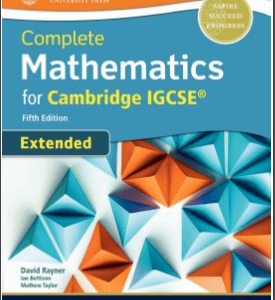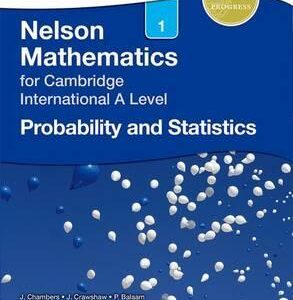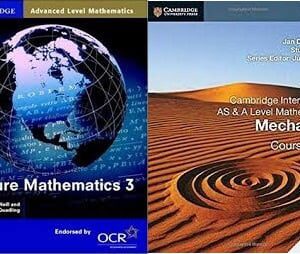What is Epsilon & Delta definition of a limit?
Let f be a function defined on a domain D containing the point c. We say that the limit of f(x) as x approaches c is L, written lim_{x\to c}f(x)=L, if for every ε>0, there exists δ>0 such that for all x in D such that 0<|x-c|<δ, we have |f(x)-L|<ε.
In other words, the limit of f(x) as x approaches c is L if for any positive number ε, we can find a positive number δ such that whenever x is within δ of c, then f(x) is within ε of L.
Our first encounter with limits pertains to its epsilon-delta definition. To give you an intuitive feeling of a limit of a function we concentrate on the graphical interpretation. The results of which we confirm analytically using inequalities.
We begin with a particular function;
observe that when x=1, this function is not defined: that is, f(1) does not exist. The function is defined, however, when x is any other real number. We shall investigate the function values when x is close to 1 but not equal to 1. You may ask why we would wish to consider such function values. The following example addresses that question.
If you don’t find enough time to complete this article in a single read, make sure to BOOKMARK this page for future saturation if you don’t want to miss this useful content.
BRIEF EXPLANATION OF EPSILON DELTA DEFINITION OF A LIMIT: Why epsilon ϵ always comes first than delta δ?
Weierstrass first introduced the epsilon-delta definition of limit in the form it is commonly written these days. He was also the one who presented the notations lim and limx→x0. The credit of modern notation of placing the arrow below the limit symbol goes to G.H.Hardy, which he introduced in his book “A Course Of Pure Mathematics” in 1908.
Now, in order to understand the epsilon-delta definition of limits in its simplest form, I have used the following simple example.
The point P(1,2) is on the curve with the equation y = 2×2 + x – 1. Let Q(x, 2×2 + x – 1) be another point on this curve, distinct from P. Figures 1 & 2 each show a portion of the graph of the equation and the secant line through Q and P where Q is near P. In Figure 1 the x-coordinate of Q is less than 1, and in Figure 2 it is greater than 1. Suppose f(x) is the slope of the line PQ.

Then;
which is equation (1). Furthermore, x ≠1 P and Q are distinct points. As x gets closer and closer to 1, the values of f(x) get closer and closer to the number which we are going to discuss just below in this example which will take us to the epsilon-delta definition of limit.
Returning now to function f defined in equation (1), let us compute function values f(x) when ‘x’ takes on the numbers 0, 0.25, 0.50, 0.75, 0.9, 0.99, 0.999, 0.9999, 0.99999, and so on. We are taking ‘x’ closer and closer to 1 but less than 1; in other words, the variable ‘x’ is approaching 1 through numbers that are less than 1. The flowing table gives the function values of these numbers.
Table 1
| x | f(x) |
| 0 0.25 0.50 0.75 0.90 0.99 0.999 0.9999 0.99999 | 3 3.5 4 4.5 4.8 4.98 4.998 4.9998 4.99998 |
Now let the variable ‘x’ approaches 1 through numbers that are greater than 1; that is, let ‘x’ take on the numbers 2, 1.75, 1.5, 1.25, 1.1, 1.01, 1.001, 1.0001, 1.00001, and so on. The function values of these numbers appear in the following table.
Table 2
| x | f(x) |
| 2 1.75 1.50 1.25 1.10 1.01 1.001 1.0001 1.00001 | 7 6.5 6.0 5.5 5.2 5.02 5.002 5.0002 5.00002 |
WE ARE NOW GETTING CLOSER TO THE EPSILON DELTA DEFINITION: KEEP READING
Observe from both tables that as ‘x’ gets closer and closer to 1, f(x) gets closer and closer to 5; and the closer ‘x’ to 1, the closer f(x) is to ‘5’.
For instance, from Table 1;
When x=0.9, f(x) = 4.8, i.e., when x is 0.1 less than 1, f(x) is 0.2 less than 5.
When x= 0.999, f(x) = 4.998; i.e., when x is 0.001 less than 1, f(x) is 0.002 less than 5.
Furthermore, when x= 0.9999, f(x) = 4.9998; i.e., when x is 0.0001 less than 1, f(x) is 0.0002 less than 5.
Table 2 shows that;
When x= 1.1, f(x) = 5.2; i.e., when x is 0.1 greater than 1, f(x) is 0.2 greater than 5.
When x = 1.001, f(x)= 5.002; i.e., when x is 0.001 greater than 1, f(x) is 0.002 greater than 5.
When x = 1.0001, f(x)= 5.0002; i.e., when x is 0.0001 greater than 1, f(x) is 0.0002 greater than 5.
Therefore, from the two tables we see that when x differs from 1 by ±0.001, (i.e., x= 0.999 or x= 1.001), f(x) differs from 5 by ±0.002 (i.e., f(x) = 4.998 or f(x) = 5.002). And when x differs from 1 by ±0.0001, f(x) differs from 5 by ±0.0002.
Now, looking at the situation another way, we consider the values of f(x) first.
We see that we can make the value of f(x) as close to 5 as we please by taking x close enough to 1; that is, |f(x)-5|can be made as small as we please by making |x-1|small enough. But bear in mind that x never takes on the value 1.
This condition can be denoted more precisely by using two symbols for the small differences. The symbols usually used are the Greek letters epsilon (ϵ) and delta (δ). So, we state that for any given positive number epsilon (ϵ) there is an appropriately chosen positive number delta (δ) such that, if |x-1| < δ and |x-1| ≠ 0 (i.e., x ≠1), then |f(x)-5| < ϵ.
It is important to realize that ϵ is chosen first and that the size of δ depends on the size of ϵ.
Still another way of phrasing this is; given any positive number epsilon (ϵ), we can make |f(x)-5| < ϵ by taking |x-1| small enough; that is, there is some sufficiently small positive number delta (δ) such that;
If 0 < |x-1| < δ then |f(x)-5| < ϵ
GRAPHICAL INTERPRETATION OF EPSILON DELTA DEFINITION OF A LIMIT
Let us see what all this means graphically for this particular function;
The following figure illustrates the geometrical significance of epsilon and delta (ϵ, δ). Observe that if x on the horizontal axis lies between 1-δ and 1+δ, then f(x) on the vertical axis will lie between 5-ϵ and 5+ϵ; or, equivalently.
If 0 < |x-1| < δ then |f(x)-5| < ϵ

DEFINITION OF LIMIT OF A FUNCTION W.R.T. EPSILON DELTA
Let f be a function defined at every number in some open interval containing a, except possibly at the number itself. The limit of f(x) as x approaches a is L, written as;
If the following statement is true:
Given any ϵ >0, however small, there exists a δ>0 such that,
If 0 < |x-a| < δ then |f(x)-L| < ϵ
IMPORTANT THEOREMS OF LIMIT OF A FUNCTION
1) LIMIT OF A LINEAR FUNCTION:- If m and b are any constants.
limx→a (mx+b) = ma +b
2) LIMIT OF A CONSTANT:- If c is a constant then for any number a
limx→a c = a
3) LIMIT OF THE IDENTITY FUNCTION:-
limx→a x = a
4) LIMIT OF THE SUM AND DIFFERENCE OF THE TWO FUNCTIONS:- If limx→a f(x) = L and limx→a g(x) = M, then
limx→a [f(x) ± g(x)] = L ± M
we can generalize this theorem for ‘n’ number of functions as well.
limx→a [f1(x) ± f2(x) ± ………. ± fn(x)] = L1 ± L2 ± ……… ± Ln
5) LIMIT OF THE PRODUCT OF TWO FUNCTIONS:- If limx→a f(x) = L and limx→a g(x) = M, then
limx→a [f(x) . g(x)] = L . M
we can generalize this theorem for ‘n’ number of functions as well.
limx→a [f1(x) f2(x) . ………. . fn(x)] = L1 . L2 . ……… . Ln
6) LIMIT OF THE nth POWER OF A FUNCTION:- If limx→a f(x) = L and ‘n’ is any positive integer, then
limx→a [f(x)]n = Ln
7) LIMIT OF THE QUOTIENT OF TWO FUNCTIONS:- If limx→a f(x) = L and limx→a g(x) = M, then
limx→a [f(x)/g(x)] = L/M if M ≠ 0
8) LIMIT OF THE nth ROOT OF A FUNCTION:- If ‘n’ is a positive integer (natural number) and limx→a f(x) = L, then
limx→a n√f(x) = n√L
EPSILON DELTA PROBLEMS WITH SOLUTIONS
Q1) Given f(x) = (x2 -25)/(x-5)1
a) Use a calculator to tabulate the values of f(x) when x is 4, 4.5, 4.9. 4.99, 4.999 and when x is 6, 5.5, 5.1, 5.01, 5.001. What does f(x) appear to be approaching as x approaches 5?
b) Confirm your answer in part (a) analytically by computing limx→5 f(x).
Solution:-
a) Following tables give the values of f(x) for the specified values of x.
| x | f(x) |
| 4 4.5 4.9 4.99 4.999 | 9 9.5 9.9 9.99 9.999 |
| x | f(x) |
| 6 5.5 5.1 5.01 5.001 | 11 10.5 10.1 10.01 10.001 |
From the tables, f(x) appears to be approaching 10 as x approaches 5.
b) We can’t apply limit to the quotient;
because limx→5 (x-5) =0. However, factoring the numerator we obtain;
If x ≠ 5, the numerator and denominator can be divided by x-5 to obtain x+5. Remember that when computing the limit of a function as x approaches 5, we are considering values of x close to 5 but not equal to 5. Therefore, it is possible to divide the numerator and denominator by x-5. The solution takes the following form;
Applying limit we get;
Q2) Given g(x) = (√x -2)/(x-4),
a) Use a calculator to tabulate to four decimal places values of g(x) when x is 3, 3.5, 3.9, 3.99, 3.999 and when x is 5, 4.5, 4.1, 4.01, 4.001. What does g(x) appear to be approaching as x approaches 4?
b) Confirm the answer in part (a) analytically by computing limx→4 g(x).
Solution:-
The following tables give the values of g(x) for the specified values of x.
| x | g(x) |
| 3 3.5 3.9 3.99 3.999 | 0.2679 0.2583 0.2516 0.2502 0.2500 |
| x | g(x) |
| 5 4.5 4.1 4.01 4.001 | 0.2361 0.2426 0.2485 0.2498 0.2500 |
From the above tables, g(x) appears to be approaching 0.2500 as x approaches 4.
b) Likewise Q1 we can’t apply limit directly to the denominator of g(x) because as limx→4 (x-4) =0 this will lead limx→4 g(x) undefined.
To simplify the quotient we rationalize the numerator and denominator by √x +2.
Because we are evaluating the limit as x approaches 4, we are considering values of x close to 4 but not equal to 4. Hence we can divide the numerator and denominator by x-4. Therefore,
if x ≠ 4. The solution is as follows;
USES OF LIMIT OF A FUNCTION IN PRACTICAL LIFE: Whats the use of studying it?
Real-life applications of the limit of a function aren’t that many, but the impact of Calculus in our daily life is damn strong, and without the limit concept Calculus is nothing.
Without the limit, derivatives (instantaneous rate of change) would not exist. Without differentiation, there is no integration, nor calculus and a large part of physics would be crashing down. No exhaustive mathematical explanation for any curves (higher degree functions), no signal processing (because of Fourier analysis) means no mp3, video, WiFi, etc.
From the design of the planes to the design of your phone, from building skyscrapers to the insurance rates, quantum physics, electrodynamics, partly chemistry, biology, pharmacokinetics, economics, fluid mechanics, heat and mass transfer, etc, all deal with limits, derivatives, integration, differential equations or partial differential equations.
Fluid mechanics is used to understand the mechanism of circulatory system, how to get drones, rockets, and planes to fly, also it helps to understand the weather behaviour.
Heat and mass transfer are used to understand the function of delivery devices, how kidney dialysis happens, and how to control heat for temperature-sensitive things and helps in designing fire-proof materials. It probably also explains why thermoses work!
Electromagnetism is used for all electricity generation and regulation, and everything that involves light, from X-rays to pulse oximetres, radiotherapy linear accelerators, Cobalt-60 units, Caesium-137 therapy units, low to orthovoltage x-ray units, high dose and low dose rate brachytherapy units, laser devices and much more.
You cannot understand these things without partial differential equations (PDEs), as partial differential equations allow a far better understanding and much wider applications (since the PDEs generalize the concepts across time and space more than the non-PDE methodologies).
CONCLUSION
Thus, if the limits weren’t been presented the current civilization would haven’t been experiencing this much growth in science and technology; life wouldn’t be that easier. Beyond doubt, limits have practically no real-life significance, however, it is the basic foundation of calculus.
Faqs related to Epsilon Delta definition of a limit
Q1) What is ε?
Ans) ε is a positive number that measures how close f(x) must be to L.
Q2) What is δ?
Ans) δ is a positive number that measures how close x must be to c.
Q3) Why do we need these two epsilon-delta variables?
Ans) We need two variables because we are talking about two different types of closeness. ε measures the closeness of f(x) to L, and δ measures the closeness of x to c.
Q4) What does it mean to “implies”?
Ans) The implication |x-c|<δ implies |f(x)-L|<ε means that if the first statement is true, then the second statement must also be true.
Q5) How do I find δ?
Ans) To find δ, we need to experiment with different values of ε. We start with a small value of ε and keep increasing it until we find a value of δ that works.
Q6) What if I can’t find δ?
Ans) If you can’t find δ, then it means that the limit does not exist.
Q7) What is the difference between the epsilon-delta definition and the graphical definition of a limit?
Ans) The graphical definition of a limit is a way of visualizing the epsilon-delta definition. It says that the limit of f(x) as x approaches c is L if the graph of f(x) approaches the line y=L as x approaches c.
Q8) Why is the epsilon-delta definition so important?
The epsilon-delta definition is important because it is a precise and rigorous way of defining limits. It is also the standard definition of limits in calculus and mathematical analysis.
Q9) How can I use the epsilon-delta definition to solve limit problems?
Ans) To solve limit problems using the epsilon-delta definition, we need to follow these steps:
- Choose a value of ε.
- Find a value of δ such that |x-c|<δ implies |f(x)-L|<ε.
- Prove that the value of δ you found works.
Related Articles:
Continuous Vs Discontinuous Functions
Piecewise Functions: How to Graph Piecewise Functions
Squeeze Theorem & Continuity of Trigonometric Functions
Do you want to boost your academic grades?
Feel free to contact us for qualitative and standardized online Mathematics tuition service
CLICK THE LINKS BELOW
For more swift and confident interaction, become a part of our WhatsApp community









